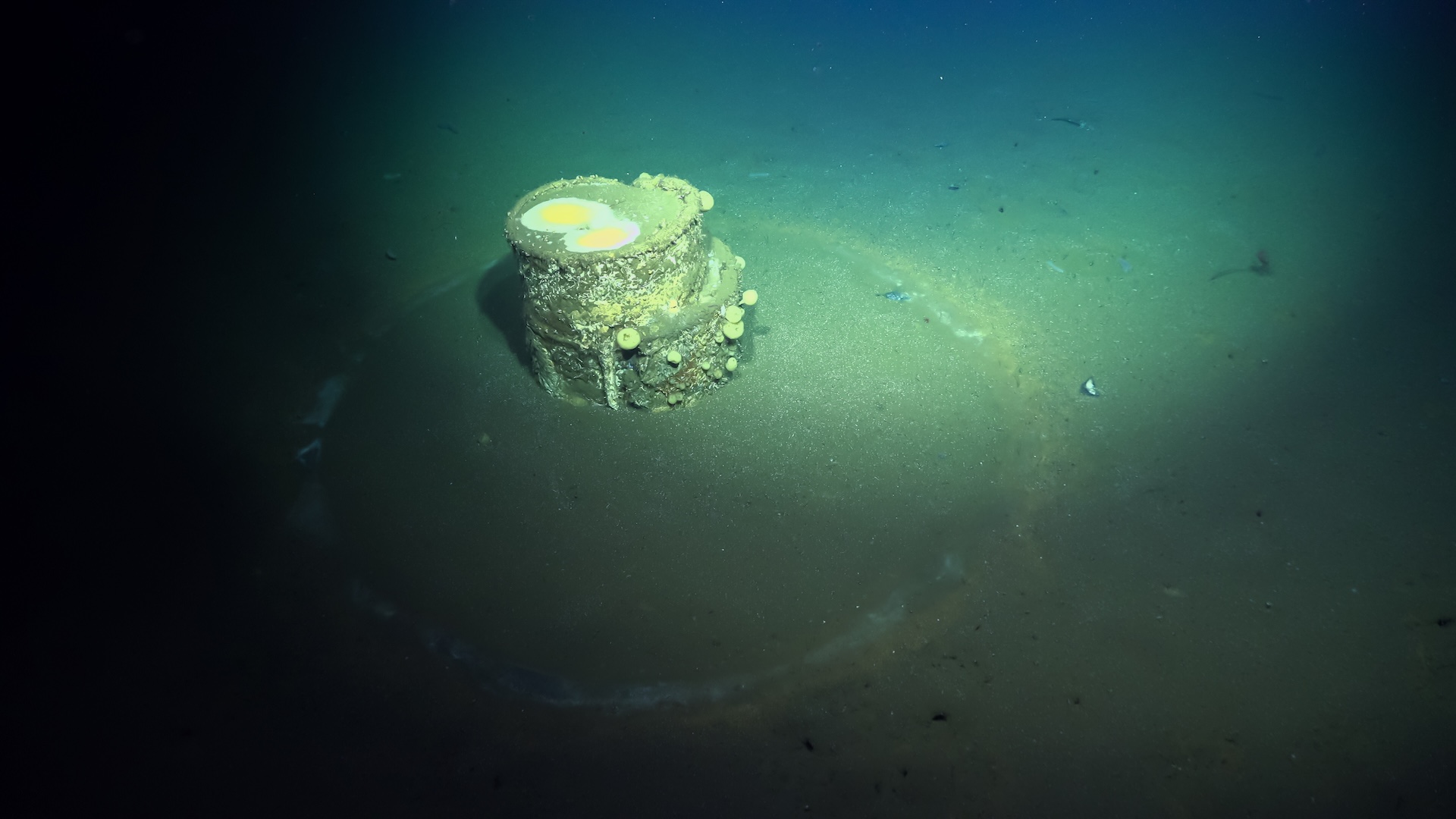Scientists are finally learning what’s inside mysterious ‘halo’ barrels submerged off Los Angeles
By Chris Simms
Copyright livescience

Skip to main content
Close main menu
Live Science
Sign up to our newsletter
View Profile
Search Live Science
Planet Earth
Archaeology
Physics & Math
Human Behavior
Science news
Life’s Little Mysteries
Science quizzes
Newsletters
Story archive
Bright orange shark discovered
Egyptian queen coin found in Jerusalem
Do humans and chimps share 99% DNA?
Comet 3I/ATLAS’s tail growing
Blood moon in photos
Don’t miss these
Rivers & Oceans
Earth’s oceans are a ‘ticking time bomb’ as acidity levels enter ‘danger zone,’ study suggests
Planet Earth
Toxic chemicals that pollute groundwater are formed up in the stratosphere, surprise findings show
First-of-its-kind footage captures bizarre sea creatures flourishing in extreme depths of the ocean
Mystery of why sea stars keep turning into goo finally solved — and it’s not what scientists thought
Industrial waste is turning into a new type of rock at ‘unprecedented’ speed, new study finds
Rivers & Oceans
Chinese submersible explores previously unknown giant craters at the bottom of the Pacific — and they’re teeming with life
Our gut bacteria can absorb and remove toxic ‘forever chemicals’ — at least in lab mice
Planet Earth
Scientists discover that mysterious giant structures beneath the North Sea seemingly defy what we know about geology
A mysterious barrier in the Atlantic divides weird deep-sea jellyfish cousins
Rivers & Oceans
96% of oceans worldwide experienced extreme heatwaves in 2023, new study finds
‘It was so unexpected’: 90 billion liters of meltwater punched its way through Greenland ice sheet in never-before-seen melting event
Trippy liquid ‘fireworks’ appear when scientists try to mix unmixable fluids
Microbiology
Embattled ‘arsenic life’ paper retracted by journal Science 15 years after publication
Enormous blobs deep beneath Earth’s surface appear to drive giant volcanic eruptions
Antarctic sea ice collapse linked to a mysterious spike in ocean salt
Planet Earth
Scientists are finally learning what’s inside mysterious ‘halo’ barrels submerged off Los Angeles
Chris Simms
9 September 2025
At first thought to hold the pesticide DDT, some mysterious barrels dumped in the deep sea near Los Angeles actually contain caustic alkaline waste that stops most life from living nearby.
When you purchase through links on our site, we may earn an affiliate commission. Here’s how it works.
The toxic barrels, which came to public attention in 2020, appear to have “halos” around them — and researchers have finally figured out why.
(Image credit: Schmidt Ocean Institute.)
Thousands of barrels of industrial waste litter the ocean floor off Los Angeles and have been there for decades — but scientists still don’t fully understand what chemicals this junkyard is leaking into the environment.
Now, research has revealed that some of the chemicals leaking from the barrel graveyard have been identified as strongly alkaline, the chemical opposite of acidic — and they are still concentrated enough to stop most life living nearby.
Between the 1930s and early 1970s, radioactive waste, refinery waste, chemical waste, oil-drilling waste and military explosives were dropped into 14 dump sites in deep water off the coast of Southern California, according to the U.S. Environmental Protection Agency.
You may like
Earth’s oceans are a ‘ticking time bomb’ as acidity levels enter ‘danger zone,’ study suggests
Toxic chemicals that pollute groundwater are formed up in the stratosphere, surprise findings show
First-of-its-kind footage captures bizarre sea creatures flourishing in extreme depths of the ocean
This huge underground junkyard came into the public consciousness in 2020, when an LA Times article revealed that deep-sea robot surveys had discovered dozens of barrels littered over the sea floor. Then, in 2021 and 2023, follow-up surveys by the Scripps Institution of Oceanography in California identified some 27,000 shapes that seemed to be barrels and more than 100,000 total debris objects on the seafloor. Some suspected that the barrels, many of which were encircled by whitish haloes in the sediment, contained the now-banned pesticide DDT, because the area is heavily contaminated with it.
But to this day, the total number of barrels on the seafloor — and what most of them contain — remains unknown.
Now, Johanna Gutleben, a microbiologist at the Scripps Institution, and her colleagues have revealed the results of sediment samples taken near five barrels using a remotely operated vehicle in 2021. They found that levels of DDT contamination didn’t increase closer to the barrels, so they say the drums didn’t contain that chemical.
Related: Alaska’s rivers are turning bright orange and as acidic as vinegar as toxic metal escapes from melting permafrost
Sign up for the Live Science daily newsletter now
Get the world’s most fascinating discoveries delivered straight to your inbox.
Contact me with news and offers from other Future brandsReceive email from us on behalf of our trusted partners or sponsorsBy submitting your information you agree to the Terms & Conditions and Privacy Policy and are aged 16 or over.
Three of the barrels they checked had white halos around them and all the samples from near these barrels had an extremely high pH (around 12) and very few microbes living there, so the team say the barrels contained caustic alkaline waste, which can damage organic matter and leach out high concentrations of potentially toxic metals.
The team’s study was published Tuesday (Sept. 9) in the journal PNAS Nexus.
“Up to this point we have mostly been looking for DDT. Nobody was thinking about alkaline waste before this and we may have to start looking for other things as well,” Gutleben said in a statement.
The sampling didn’t identify which specific chemicals were in the barrels, but notably, DDT manufacturing produces alkaline waste, as does oil refining.
“One of the main waste streams from DDT production was acid and they didn’t put that into barrels,” said Gutleben. “It makes you wonder: What was worse than DDT acid waste to deserve being put into barrels?”
As the researchers found very limited levels of microbial DNA near the barrels, they say the alkali waste likely transformed parts of the seafloor into extreme environments where most life can’t survive. They did find traces of some specialized bacteria, though — species from families adapted to alkaline environments, like deep-sea hydrothermal vents and alkaline hot springs.
The team also discovered how the weird haloes form. When the alkaline waste leaks from the barrels, it reacts with magnesium in the water and creates a mineral form of magnesium hydroxide, called brucite, forming a concrete-like crust. The brucite then slowly dissolves, keeping the pH in the sediments high while leading to reactions in surrounding seawater. This results in the formation of calcium carbonate, which settles as white dust around the barrels.
RELATED STORIES
—Tens of millions of devices are thrown away each year — and the rise of generative AI will only make this worse
—Scientists transform ‘forever chemicals’ in water into fluoride with new process
—’This technology is possible today’: Nuclear waste could be future power source and increase access to a rare fuel
Given that the alkaline waste has persisted for more than half a century, rather than quickly dissipating in the seawater, it suggests that it should be considered a persistent pollutant with long-term environmental impacts, similar to DDT, study co-author Paul Jensen, also at the Scripps, said in the statement.
“It’s shocking that 50-plus years later you’re still seeing these effects,” he said.
The researchers suggest using the white halos to identify which barrels contain alkaline waste so the overall extent of contamination can be assessed. Jensen said roughly one-third of the barrels that have been seen so far have halos, but it’s unclear if this ratio will hold as more barrels are uncovered.
Chris Simms
Live Science Contributor
Chris Simms is a freelance journalist who previously worked at New Scientist for more than 10 years, in roles including chief subeditor and assistant news editor. He was also a senior subeditor at Nature and has a degree in zoology from Queen Mary University of London. In recent years, he has written numerous articles for New Scientist and in 2018 was shortlisted for Best Newcomer at the Association of British Science Writers awards.
You must confirm your public display name before commenting
Please logout and then login again, you will then be prompted to enter your display name.
Earth’s oceans are a ‘ticking time bomb’ as acidity levels enter ‘danger zone,’ study suggests
Toxic chemicals that pollute groundwater are formed up in the stratosphere, surprise findings show
First-of-its-kind footage captures bizarre sea creatures flourishing in extreme depths of the ocean
Mystery of why sea stars keep turning into goo finally solved — and it’s not what scientists thought
Industrial waste is turning into a new type of rock at ‘unprecedented’ speed, new study finds
Chinese submersible explores previously unknown giant craters at the bottom of the Pacific — and they’re teeming with life
Latest in Pollution
Golden river of toxic waste spills out from deadly mining disaster in South Africa
What are the most polluted cities in the world?
Even brief exposure to diesel fumes alters activity in key brain network, study finds
Monet and Turner’s atmospheric landscapes actually depicted air pollution, new study finds
Hole in the ozone layer has grown for a 3rd year in a row — but scientists aren’t concerned
Light pollution: Environmental impact, health risks and facts
Latest in News
Scientists are finally learning what’s inside mysterious ‘halo’ barrels submerged off Los Angeles
Microsoft’s new light-based computer is inspired by 80-year-old technology — it could make AI 100 times more efficient
‘Extraordinary’ Roman helmet from war-ending battle found in the sea off Sicily
New photos of comet 3I/ATLAS reveal its tail growing before our eyes
‘Blood moon’ gallery: Stunning snaps from last night’s total lunar eclipse
‘I trust AI the way a sailor trusts the sea. It can carry you far, or it can drown you’: Poll results reveal majority do not trust AI
LATEST ARTICLES
Microsoft’s new light-based computer is inspired by 80-year-old technology — it could make AI 100 times more efficient
I watched scientists view the interstellar comet 3I/ATLAS in real time. Here’s what they saw.
Giant ‘chessboard’ surrounds Idaho river in bizarre astronaut photo — Earth from space
‘Extraordinary’ Roman helmet from war-ending battle found in the sea off Sicily
New photos of interstellar comet 3I/ATLAS reveal its tail growing before our eyes
Live Science is part of Future US Inc, an international media group and leading digital publisher. Visit our corporate site.
Contact Future’s experts
Terms and conditions
Privacy policy
Cookies policy
Accessibility Statement
Advertise with us
Web notifications
Editorial standards
How to pitch a story to us
Future US, Inc. Full 7th Floor, 130 West 42nd Street,
Please login or signup to comment
Please wait…



